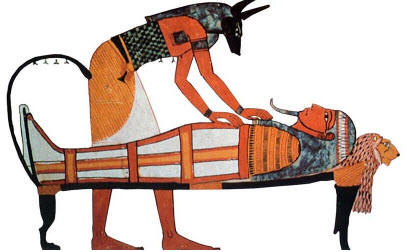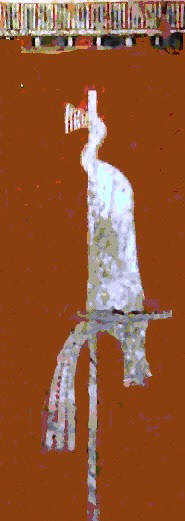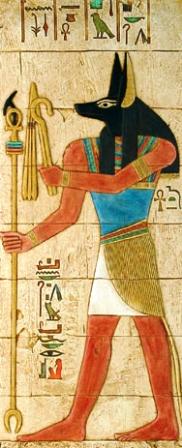
| Anubis, god of Egypt | 
|
|
Ancient Egyptian Gods and Goddesses for kids - Anubis The Mythology & History of ancient Egypt surrounding the Egyptian god of the dead |
|
Anubis, god of Egypt
Discover the legends and myths and religious beliefs surrounding Anubis, the Egyptian god of the dead, Tombs and Embalming. Anubis was depicted with the body of a man and the distinctive black head of a Jackal or dog. The Underworld was called Duat and believed to be full of terrible, great dangers. Anubis greeted the souls in the Underworld and was believed to protect them on their journey. The jackal headed god was also associated with the ritual of mummification. mummification. According to the creation myth in ancient Egyptian mythology he was believed to be the son of the God Osiris and the Goddess Nephthys. Additional information about ancient gods is also available via: |
|
Facts about Anubis
The role of Anubis was connected with the mummification of the death and the journey through the afterlife. Anubis guided the souls of the dead through the underworld kingdom of his powerful father, Osiris, and played an important role in the mythical rituals of the Underworld, in particular the weighing of the heart to determine the eternal fate of a soul of the dead. The following fact sheet and profile provides a fast overview of this famous Egyptian god:
Anubis Profile & Fact File | | Egyptian Name: | Anubis | | Role & Function: | His function is described as being the god of the dead, tombs and embalming | | Province: | The Underworld (Duat) | | Symbols: | Imiut fetish, the flail, the crook and a 'was' sceptre, the jackal dog | | Alternative Names: | Anpu, Anup and Imiut (Lord-of-the-Place-of-Embalming) | | Status: | He was a member of the Ennead, the name given to the nine original, most important, Egyptian Gods and Goddesses of the cosmogony of Heliopolis (the birthplace of the Gods) | | Name of Wife: | Anput who was depicted with the body of a woman and head of a jackal | | Name of Father: | Osiris | | Name of Mother: | Nephthys | | Names of Children: | Kebechet, the goddess of purification | | Names of Siblings: | Horus |
| Anubis the god with the Jackal Head
Anubis was the Egyptian god of the dead, depicted with the black head of a jackal or dog. Many Egyptian gods were perceived as 'human hybrids' depicted with human bodies with the heads of animals. The ancient Egyptians did not worship animals - the depiction of a god as an animal was a device to visually convey the identity, qualities and attributes of the god. Egyptian Gods, like Anubis, were always depicted as young & healthy. Any gods with black symbols (like the black headed jackal symbol of Anubis) were closely connected with death and the Afterlife. 
Anubis in Egyptian Mythology - The Book of the Dead
Anubis, the Egyptian god of the dead, featured in many of the stories, myths and legends in Egyptian Mythology. A major source of information about the ancient Egyptian view of the Underworld was found in an extensive ancient papyrus, called the Book of the Dead. This 'book' was commissioned by an scribe called Ani and depicts the dangers and a vision of the Underworld. The purpose of creating the Book of the Dead was to prepare Ani and his wife for the ordeals they would encounter with the correct responses to questions they would be asked by the gods. It was an ancient survival guidebook which contained magical spells and instructions to ensure safe passage through the dangers of the Underworld. The journey through the Underworld, guided by Anubis, culminates in the ceremony of justification in the Hall of the Two Truths witnessed by Osiris and 42 judge deities. The heart was weighed on a set of scales against the feather of truth and their fate would be decided - either entrance into the perfect afterlife or to be sent to the Devourer of the Dead. Additional facts and information are detailed in the Concept of the soul, the Ka and Ba. |
|

| The Symbols of Anubis - The Imiut Fetish
The Imiut fetish, or Anubis fetish, was present in ancient Egyptian funerary rites. A fetish was object that was believed to embody the magical powers of a particular spirit, in this instance Anubis, and used to create a bond between the mortal world and supernatural realm of the Underworld. A fetish represented the spirit to it's owner and acted as a means of protection on a journey, like an amulet or talisman. The Imiut fetish, took the form of a stuffed, headless animal skin which was tied by the tail to a pole that terminated in a lotus bud. Beautiful, stylised versions of the Imiut fetish were also created for pharaohs or wealthy Egyptians in gold. The fetish was positioned on a stand which was placed in the tomb of the deceased. Fantastic golden Imiut fetishes were discovered in the tombs of Tutankhamen and Hatshepsut. The Symbols of Anubis - Flail, crook & sceptre
The other symbols of Anubis were the flail, a crook and a 'was' sceptre. A flail was an agricultural tool used for winnowing grain. The flail symbolized the Pharaoh's role as provider of food for his people and the crook symbolized the Pharaoh's role as the 'shepherd' of his people. The long staff, called a 'was' sceptre, was a symbol of divine power and an emblem of authority. These symbols linked the divine power of the Pharaohs with the power of the ancient Egyptian gods. The 'was' sceptre was also believed to be another type of magical fetish. | 
|
Anubis and the black head of the Jackal
Anubis was depicted with the black head of the jackal even though real jackals are typically brown. The black jackal head of this jackal-god was characterized by its long, alert ears and a pointed muzzle. The color black was highly significant as it was a symbol of death, the color of rotting flesh, and symbolized the Underworld and the night. Black was also associated with the black soil of the Nile valley and as such also symbolized rebirth. There are many theories as to why the jackal was associated with Anubis. Some say it is because jackals were known to frequent the edges of the desert, near the cemeteries where the dead were buried. The first tombs were built to keep wild animals, like jackals, from desecrating the dead. Anubis Statue
Many statues representing Anubis were simply of a jackal upon a pedestal as seen in the beautiful examples from the tomb of Tutankhamun. 
Statue found in the tomb of tomb of Tutankhamun |
|
Anubis- The jackal headed god
- Interesting research information and Facts about the Egyptian god Anubis
- Anubis, the Egyptian god of the dead
- Stories and Legends in Egyptian Mythology associated with Anubis
- Facts and information about the gods and deities of of classical Egypt for schools, research and kids
- The Egyptian god of the dead
|
| | |
|
Facts about Anubis in Egyptian Mythology and History
Discover interesting information and research facts about Anubis, the Egyptian god of the dead. The facts about Anubis provides a list detailing fascinating additional info to increase your knowledge about Anubis in Egyptian Mythology and history. Facts about Anubis from Mythology and History |
Fact 1 about Anubis: |
One of the important roles of Anubis was as the "Guardian of the Scales" in the Underworld when the hearts of dead souls were weighed
| | Fact 2 about Anubis: | He was the son of Nephthys and Osiris
| | Fact 3 about Anubis: | According to Egyptian mythology Nephthys had made Osiris drunk, drawn him to her arms without his knowledge, and gave birth to a son, the jackal god Anubis
| | Fact 4 about Anubis: | He was credited with the invention of embalming, an art he first practiced on the corpse of Osiris
| | Fact 5 about Anubis: | He conducted and guided the dead through the Underworld to judgment in the Hall of Truths
| | Fact 6 about Anubis: | He was associated with with the process of embalming and mummification. He was widely worshipped throughout all of Egypt and his cult center was Cynopolis.
| | Fact 7 about Anubis: | Prayers to the god Anubis are found carved on the most of the most ancient tombs in Egypt
| | Fact 8 about Anubis: | His mother, Nephthys, left her son exposed to the elements. Instead of dying, he was found by Isis, who then raised him. He became the faithful attendant of Isis
| | Fact 9 about Anubis: | After Set had killed Osiris and scattered his remains, Anubis helped Isis and Nephthys to rebuild his body and presided over the first mummification
| | Fact 10 about Anubis: | During the embalming process, the head priest-embalmers (the "Higher Mysteries") wore a jackal mask bearing the image of Anubis Apuat was another form of Anubis. In other instances, Apuat was another name for Anubis or Wepwawet, another
jackal-headed god.
| 
The name of Anubis in hieroglyphs Refer to Hieroglyphics | Facts about Anubis from Mythology and History |
|
|
|
|